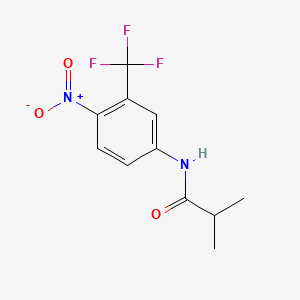Drug Information
Drug (ID: DG01464) and It's Reported Resistant Information
| Name |
Flutamide
|
||||
|---|---|---|---|---|---|
| Synonyms |
Flutamide; 13311-84-7; Eulexin; Niftolide; Niftholide; 2-Methyl-N-[4-nitro-3-(trifluoromethyl)phenyl]propanamide; Sch 13521; NFBA; niftolid; Drogenil; Flutamin; Cebatrol, veterinary; Flutamida; Flutamidum; 4'-Nitro-3'-trifluoromethylisobutyranilide; Sch-13521; 2-Methyl-N-(4-nitro-3-[trifluoromethyl]phenyl)propanamide; N-(4-NITRO-3-(TRIFLUOROMETHYL)PHENYL)ISOBUTYRAMIDE; SCH13521; MFCD00072009; NSC 215876; Flutamide (Eulexin); alpha,alpha,alpha-Trifluoro-2-methyl-4'-nitro-m-propionotoluidide; UNII-76W6J0943E; CHEMBL806; Propanamide, 2-methyl-N-[4-nitro-3-(trifluoromethyl)phenyl]-; 4-Nitro-3-(trifluoromethyl)isobutyranilide; CHEBI:5132; Propanamide, 2-methyl-N-(4-nitro-3-(trifluoromethyl)phenyl)-; 76W6J0943E; NSC-215876; NCGC00015452-09; Eulexine; Chimax; 4'-Nitro-3'-trifluoromethylisobutyramilide; CAS-13311-84-7; Ham's F-12 medium; Flutamidum [INN-Latin]; DSSTox_CID_11121; DSSTox_RID_78899; DSSTox_GSID_32004; Flutamida [INN-Spanish]; Flutamide USP25; N-[4-Nitro-3-(trifluoromethyl)phenyl]isobutyramide; Prostandril; Odyne; SMR000058187; Eulexin (TN); CCRIS 7246; m-Propionotoluidide,.alpha.,.alpha.-trifluoro-; SR-01000075888; EINECS 236-341-9; BRN 2157663; .alpha.,.alpha.-Trifluoro-2-methyl-4'-nitro-m-propionotoluidide; m-Propionotoluidide,.alpha.,.alpha.-trifluoro-2-methyl-4'-nitro-; 4'-Nitro-3'-(trifluoromethyl)isobutyranilide; Flutamide [USAN:USP:INN:BAN]; Flutamide,(S); Prestwick_228; NK-601; Spectrum_001210; 2-Methyl-N-[4-nitro-3-(trifluoromethyl)phenyl]propionamide; CPD000058187; Prestwick0_000180; Prestwick1_000180; Prestwick2_000180; Prestwick3_000180; Spectrum2_001201; Spectrum3_001421; Spectrum4_000829; Spectrum5_001450; Lopac-F-9397; F0663; Flutamide (pubertal study); F 9397; SCHEMBL3934; Lopac0_000557; BSPBio_000079; BSPBio_003122; KBioGR_001377; KBioSS_001690; MLS000069634; MLS001065596; MLS002548892; DivK1c_000459; SPECTRUM1500995; SPBio_000982; SPBio_002000; Flutamide (JP17/USP/INN); BPBio1_000087; GTPL6943; CHEMBL4759307; DTXSID7032004; SCHEMBL12932289; HMS501G21; KBio1_000459; KBio2_001690; KBio2_004258; KBio2_006826; KBio3_002342; NINDS_000459; HMS1568D21; HMS1921O16; HMS2090I18; HMS2092O14; HMS2095D21; HMS2230P19; HMS3259I03; HMS3261P15; HMS3373C12; HMS3655G22; HMS3712D21; Pharmakon1600-01500995; AMY32524; BCP23006; HY-B0022; ZINC3812944; Tox21_110154; Tox21_202169; Tox21_300536; Tox21_500557; BDBM50131270; CCG-39105; m-Propionotoluidide, 2-methyl-4'-nitro-alpha,alpha,alpha-triflouro-; NSC147834; NSC215876; NSC757817; s1908; AKOS001025465; AKOS025243203; m-Propionotoluidide, .alpha.,.alpha.,.alpha.-trifluoro-2-methyl-4'-nitro-; Tox21_110154_1; AB02835; DB00499; KS-5091; LP00557; MCULE-7498839065; NC00451; NSC-147834; NSC-757817; SDCCGSBI-0050540.P004; IDI1_000459; NCGC00015452-01; NCGC00015452-02; NCGC00015452-03; NCGC00015452-04; NCGC00015452-05; NCGC00015452-06; NCGC00015452-07; NCGC00015452-08; NCGC00015452-10; NCGC00015452-11; NCGC00015452-12; NCGC00015452-13; NCGC00015452-14; NCGC00015452-15; NCGC00015452-16; NCGC00015452-19; NCGC00015452-20; NCGC00015452-32; NCGC00091460-01; NCGC00091460-02; NCGC00091460-03; NCGC00091460-04; NCGC00091460-05; NCGC00091460-06; NCGC00091460-07; NCGC00091460-08; NCGC00091460-09; NCGC00254495-01; NCGC00259718-01; NCGC00261242-01; AC-24192; BF166239; SY036411; SBI-0050540.P003; DB-042163; 3'-Trifluoromethyl-4'-Nitro-Isobutyranilide; AB00052188; EU-0100557; FT-0626493; FT-0668764; SW196536-4; 4''-nitro-3''-trifluoromethylisobutyranilide; C07653; D00586; J10037; AB00052188-09; AB00052188_10; AB00052188_11; 311F847; A806562; Q418669; Q-201131; SR-01000075888-1; SR-01000075888-6; SR-01000075888-7; SR-01000075888-9; BRD-K28307902-001-05-0; Flutamide, certified reference material, TraceCERT(R); Z56755651; a,a,a-Trifluoro-2-methyl-4'-nitro- m-propionotoluidide; Flutamide, European Pharmacopoeia (EP) Reference Standard; 2-Methyl-N-[4-nitro-3-(trifluoromethyl)phenyl]propanamide #; Flutamide, United States Pharmacopeia (USP) Reference Standard; 2-methyl-N-[4-nitro-3-(trifluoromethyl)phenyl]propanamide;Flutamide; alpha,alpha,alpha-trifluoro-2-methyl-4''-nitro-m-propionotoluidide; .alpha.,.alpha.,.alpha.-Trifluoro-2-methyl-4'-nitro-m-propionotoluidide; m-Propionotoluidide, 2-methyl-4'-nitro-.alpha.,.alpha.,.alpha.-trifluoro-; m-Propionotoluidide, alpha,alpha,alpha-trifluoro-2-methyl-4'-nitro- (8CI); Flutamide for system suitability, European Pharmacopoeia (EP) Reference Standard; 37209-54-4
Click to Show/Hide
|
||||
| Indication |
In total 4 Indication(s)
|
||||
| Structure |

|
||||
| Drug Resistance Disease(s) |
Disease(s) with Clinically Reported Resistance for This Drug
(1 diseases)
[1]
|
||||
| Target | Candida Thymidylate synthase (Candi TMP1) | TYSY_CANAL | [1] | ||
| Dihydrothymine dehydrogenase (DPYD) | DPYD_HUMAN | [1] | |||
| TERT messenger RNA (TERT mRNA) | TERT_HUMAN | [1] | |||
| Thymidylate synthase messenger RNA (TYMS mRNA) | TYSY_HUMAN | [1] | |||
| Click to Show/Hide the Molecular Information and External Link(s) of This Drug | |||||
| Formula |
2
|
||||
| IsoSMILES |
CC(C)C(=O)NC1=CC(=C(C=C1)[N+](=O)[O-])C(F)(F)F
|
||||
| InChI |
InChI=1S/C11H11F3N2O3/c1-6(2)10(17)15-7-3-4-9(16(18)19)8(5-7)11(12,13)14/h3-6H,1-2H3,(H,15,17)
|
||||
| InChIKey |
MKXKFYHWDHIYRV-UHFFFAOYSA-N
|
||||
| PubChem CID | |||||
| ChEBI ID | |||||
| TTD Drug ID | |||||
| VARIDT ID | |||||
| INTEDE ID | |||||
| DrugBank ID | |||||
Type(s) of Resistant Mechanism of This Drug
Drug Resistance Data Categorized by Their Corresponding Diseases
ICD-02: Benign/in-situ/malignant neoplasm
| Drug Resistance Data Categorized by Their Corresponding Mechanisms | ||||
|
|
||||
| Key Molecule: Androgen receptor (AR) | [1] | |||
| Molecule Alteration | Missense mutation | p.T878A (c.2632A>G) |
||
| Resistant Disease | Prostate cancer [ICD-11: 2C82.0] | |||
| Experimental Note | Identified from the Human Clinical Data | |||
| Key Molecule: Androgen receptor (AR) | [1] | |||
| Molecule Alteration | Missense mutation | p.T877A |
||
| Resistant Disease | Prostate cancer [ICD-11: 2C82.0] | |||
| Experimental Note | Identified from the Human Clinical Data | |||
References
If you find any error in data or bug in web service, please kindly report it to Dr. Sun and Dr. Zhang.
